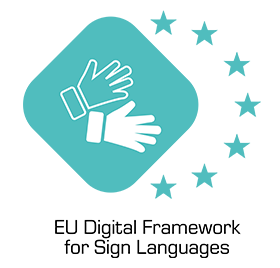Integrating deaf people into the job market is a key challenge; more than 50 % of the 1 million deaf people in Europe are unemployed, and those who are employed are often in low skilled and low-paid jobs.
Access to digital jobs and professional VET programs in ICT for deaf and hard-of-hearing people is severely affected by the lack of proper field-specific terminology in the different sign languages, although the needs analysis conducted previously to the submission of this proposal has highlighted a rising trend in deaf entrepreneurship within the digital and ICT sector (ref. field research carried out by the project “Deaf Enterprise”, KA2 2016-1-UK01-KA202-024361, see innovation and complementarity section). The employment rate in ICT is going through a really positive trend in the last years; in fact, according to Eurostat, the number of ICT specialists in the EU grew by 39.1 % from 2011 to 2018, over 6 times as high as the increase (6.5 %) for total employment (shorturl.at/bepE0).
As with any other language, a lexical wealth of sign languages gets updated in accordance with the use and diffusion of terms. New lexical resources for digital and ICT are lagging behind in sign languages, due to the common but misguided myth that written text can be sufficient for deaf people to understand and being able to express themselves, particularly with regards to the field of digital and ICT.
According to the European Federation of Hard of Hearing People, there are 52 million European citizens affected by hearing disabilities of any kind, and national sign languages are to be considered their mother tongues. Access to sign languages is comparable to a Human Right, allowing them to be fully included in the daily life of their society. As such, the existing lexicon gap in the digital and ICT domain of sign languages has to be overcome in order to guarantee equal opportunities in accessing the ‘digital community’ of professionals for people with hearing disabilities.
The project aims to develop the “EU Digital Framework for Sign Languages”, i.e. an analytical and descriptive database providing the main sign language resources in is (international sign) related to the lexical domain of digital and ICT. The framework will be mainly represented by an e-glossary containing at least 500 lemmas in IS, distributed in five key digital subdomains:
- Computer science;
- Cloud networking;
- Internet of Things (IoT);
- Artificial Intelligence (AI) and robotics
- Audio-visual and media production.
Each entry of the glossary will be augmented with a short video showing how to properly sign it plus additional information like etymology, usage scenarios and situational contexts. Where a lexical gap is detected, new signs will be developed according to the current rules of new signs formation. Apart from the language academic interest, this project pursues the full integration of D/deaf individuals into professional and VET contexts with a degree of digital/ICT intensity. Therefore, the results are thought to be used and adopted by both D/deaf and hearing people, to favour the spread of deaf culture and encourage dialogue and inclusion. To this end, the “Guidelines for the inclusion of D/deaf workers in digital and ICT settings” will be delivered in the final stage of the project.
Stay up to date on the project online:
Visit the website: www.digitalsignlanguage.eu
Follow the project activities on
- Facebook: @digitalsignlanguage
- Instagram: @eu_digitalsignlanguage
